18 Common Plumbing Problems and How to Resolve Them
Don’t let these plumbing problems throw a wrench in your budget


Common plumbing problems include clogged drains, leaky pipes, and hot water loss.
Savvy homeowners may be able to fix some simple plumbing problems on their own.
More complex issues with your plumbing should be left to professional plumbers.
Many of us take our plumbing systems for granted. We turn on a faucet and expect water immediately; we flush our toilets, and everything’s washed away at once; we load the dishwasher, press a button, and voila, clean dishes a few hours later. But plumbing problems can arise unexpectedly and become a real inconvenience—or even lead to expensive water damage to your home.
Familiarize yourself with some of the most common plumbing problems (and their fixes) so you can address issues before they become more extensive—and more expensive to repair.
1. Clogged Drain

Problem:
A clogged drain is one of the most common plumbing problems. It could happen in your kitchen sink, your bathroom sink, your tub drain, or multiple drains throughout the house. Food scraps, coffee grounds, and grease can clog kitchen sinks, while hair is often the culprit in the bathroom.
You’ll notice clogged drains if water drains slowly (or backs up entirely), but other signs of a clog include the presence of drain flies, foul odors from the drain, or gurgling sounds as the water drains.
If the clog is localized to one specific area, it’s probably an issue with one specific drain. If multiple drains are backed up, you could be dealing with a larger clog in the main line.
Solution:
Simple clogs in a kitchen sink or bathroom drain are usually an easy DIY fix. Don’t reach for that chemical drain cleaner, though. There are several other safer ways to unclog a drain. For instance, try a mixture of baking soda and vinegar, then wash it away with boiling water. For larger problems, you might need a drain snake.
If you can’t get rid of the clog on your own—or the problem lurks within the main line—hire a plumber to handle the issue. On average, main water line repair costs $975.
2. Low Water Pressure
Problem:
A shower with great water pressure can be the perfect way to start or end a day. A sudden loss of pressure in the shower, however, can be much less satisfying.
It’s not just water pressure in the shower to watch out for, though. If you suddenly notice reduced water pressure from a faucet or the garden hose, you’ll want to start investigating to find the source of the problem.
Solution:
There can be several reasons you have low water pressure. The issue could be with the utility company, so it’s always smart to ask your neighbors if they’re having issues. You may also just be running too many things at once. For instance, if the dishwasher and washing machine are going at the same time, expect less pressure from faucets and showerheads temporarily.
If you’ve confirmed your neighbors aren’t having water pressure problems, and you aren’t running multiple appliances, try to pinpoint the source of the problem. Start by checking your water valve to make sure it’s fully open.
Then, investigate each water source individually. If you suddenly have water pressure issues from all faucets and showerheads, you’ve got a larger problem, and it could be an issue with the pressure-reducing valve, water service line, well pump, or something else. If the issue is limited to a single water source, the fix might be as simple as clearing debris, like calcium deposits, from the aerator. In other instances, you may just need to replace the aerator altogether.
However, because low water pressure could indicate one of many plumbing problems—pipe corrosion, drain clogs, cracked sewer lines, or water leaks—it’s best to call a local plumbing repair company to investigate further.
3. Faucet or Shower Leaks
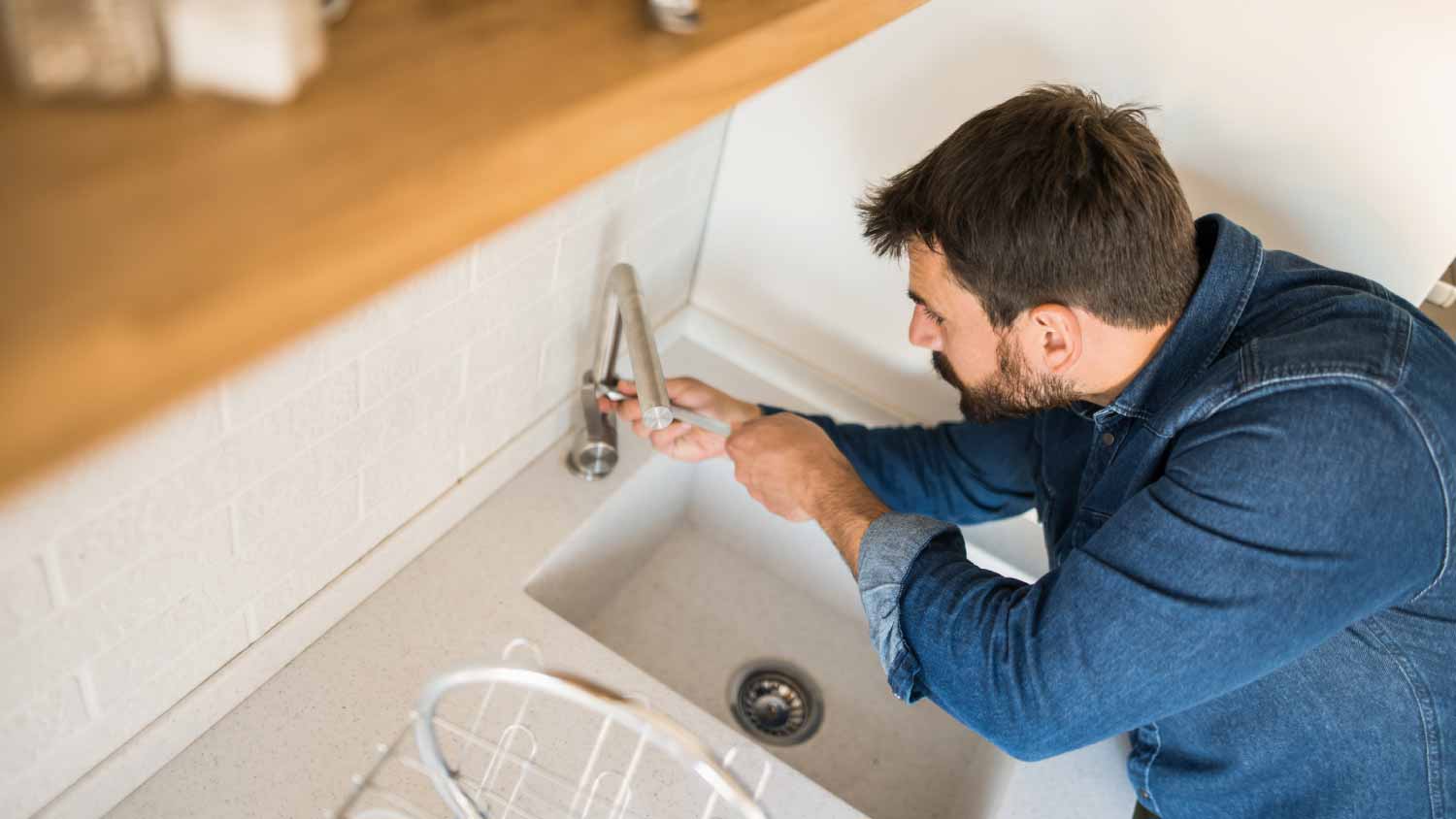
Problem:
A leaky faucet or showerhead is easy to spot, but it’s also easy to ignore. However, you’ll notice a spike in your water bill if you leave the problem unresolved, and a dripping faucet could indicate a deeper issue, like improper installation or corrosion, so it’s best to address the problem quickly.
Solution:
Knowing how to fix a leaky faucet is an important DIY skill for homeowners. Often, the fix is as simple as replacing a washer or O ring—something homeowners can usually do themselves.
However, a professional plumber will be able to tell whether you should repair or replace a leaky faucet, so if you’re not comfortable assessing the issue, it still could make sense to call a faucet professional near you.
4. Hot Water Loss
Problem:
If your faucet can no longer dispense hot water—or if it just takes a lot longer for your water to heat up—there’s likely an issue with your water heater. It could be that your tank is simply not large enough to serve your household, it may be installed in an inefficient place, or it may be nearing its end of life.
Solution:
If your water heater’s tank is too small, you’ll need to upgrade to a larger unit. You can either purchase a conventional water heater with a larger tank or a tankless water heater, which lasts longer than a traditional water heater and is more efficient. However, tankless water heaters are also more expensive. On average, a tankless water heater costs $2,500.
If the water heater is placed too far from the most-used faucets, you may have trouble getting hot water quickly. Water heater placement matters for several other reasons, as well—it should be ideally installed somewhere that won’t cause a lot of damage if it leaks.
Of course, hot water loss could indicate a larger water heater problem, so it’s a good idea to find a local hot water repair service to take a look.
5. Water Heater Issues
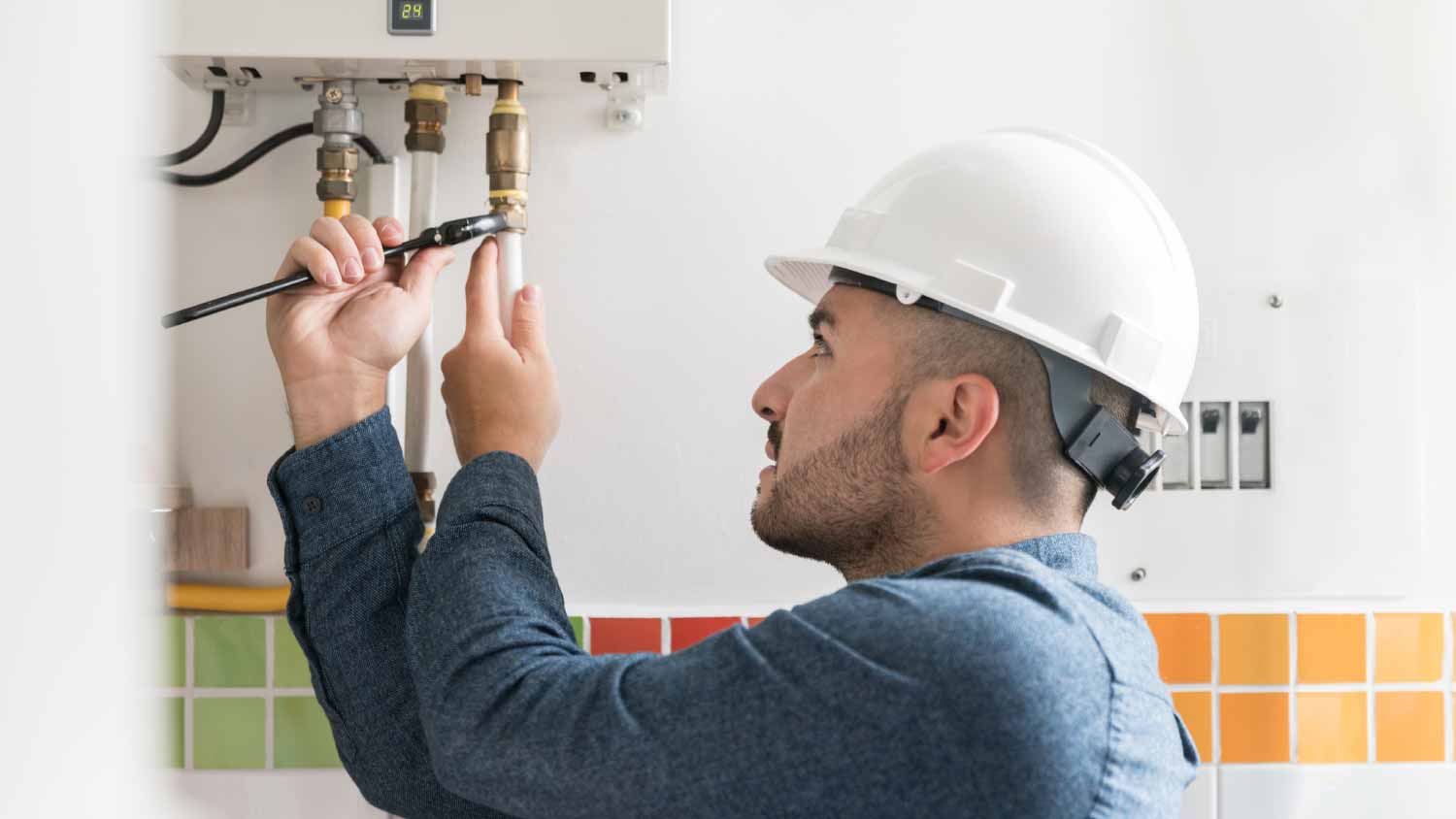
Problem:
A lack of hot water is only one of many water heater issues you could come across. Other common problems with water heaters include:
Leaky tanks
Tank corrosion
Overheating
Solution:
If you come across any water heater issues, consider the age of the unit. A conventional water heater lasts about 10 years. If you’re noticing any problems—from a leaking tank to a faulty temperature and pressure relief valve to improper water pressure—it may be best to replace the system entirely. A new water heater costs about $1,300.
If the water heater isn’t that old, however, it may make more sense to have it repaired. Call a plumber and have them assess the issue and recommend a fix. Typical water heater repair costs between $225 and $975.
6. Running Toilet
Problem:
A running toilet is one of the most common toilet problems. You’ll know you have a running toilet if you hear the sound of water running from your toilet, even when it hasn’t just been flushed. This alone should encourage you to investigate the problem, but if it gets worse, you may even notice the toilet flushes on its own or water is leaking from the side of the toilet.
Solution:
Luckily, it’s easy to learn how to fix a running toilet on your own. You’ll use food dye to pinpoint the problem, but the culprit is often the flapper seal. You can buy a repair kit for under $10 and tackle this fix on your own.
If you can’t figure out the solution or aren’t confident handling the repair after reading some how-tos or watching some videos, you can call a local toilet repair plumber to help out. Simple toilet repairs cost as little as $150.
7. Clogged Toilet

Problem:
Sure, it’s embarrassing, but it happens to everyone. Don’t sweat it: A clogged toilet can overflow and deposit waste on your floor, but the fix is usually simple. But if multiple toilets are backed up at once, you have a more disastrous problem on your hands.
Solution:
You can usually fix a clogged toilet with a plunger, but more serious toilet plumbing problems could require a drain snake. However, if the problem isn’t central to a single toilet and water and sewage is instead backing up throughout your home, there’s likely a blockage in the septic tank, sewer line, or another crucial pipe. Call a local emergency plumber immediately.
8. Leaky Pipes
Problem:
Leaky pipes may be the most common plumbing problem of all—or the one we most commonly associate with plumbers, at least. And pipe leaks can result from a number of issues, including frozen pipes, corrosion, high water pressure, cracks, joint damage, clogs, and more.
When left unfixed, leaky pipes can lead to spikes in your water bill, serious water damage to wood and masonry, mold and mildew, and even cockroach infestations.
Solution:
There are several temporary fixes for leaky pipes, but ultimately, you’ll need to call a plumber and have them fix the issue, especially if the pipe is difficult to access. Pipe leak repairs cost $500 on average, but this can depend on the type of leak, the type of pipe, and where the pipe is located.
9. Burst Pipes
Problem:
Pipe bursts are a sudden rupture in your plumbing, which can lead to severe water damage as water rapidly escapes and wreaks havoc behind walls, under fixtures, and out into your living spaces. Pipes can burst for several reasons, typically related to pressure. These reasons include:
Extreme fluctuations in temperature (frozen pipes are a common precursor to pipe bursts)
Pressure from extending tree roots
Extensive clogs that cause a buildup of pressure over time
Old age or deterioration through rust or corrosion
Solution:
If a pipe bursts in your home, shut off the water immediately to limit the damage. Then, use towels, fans, and dehumidifiers to dry the affected area as quickly as possible. Depending on the extent of the water damage, you’ll likely need to hire a water damage restoration service near you to ensure there is no long-term damage to walls, floors, and ceilings and to prevent mold and mildew growth.
You’ll also need to replace the burst pipe before turning your water back on. This is not something you should DIY; hiring a professional plumber to replace broken pipes costs between $150 and $250 per linear foot of piping. If your pipe bursts during a severe cold weather event overnight, you may need to call an emergency plumber. Emergency plumbers cost up to three times as much as a plumber during regular hours.
10. Sewer Blockages
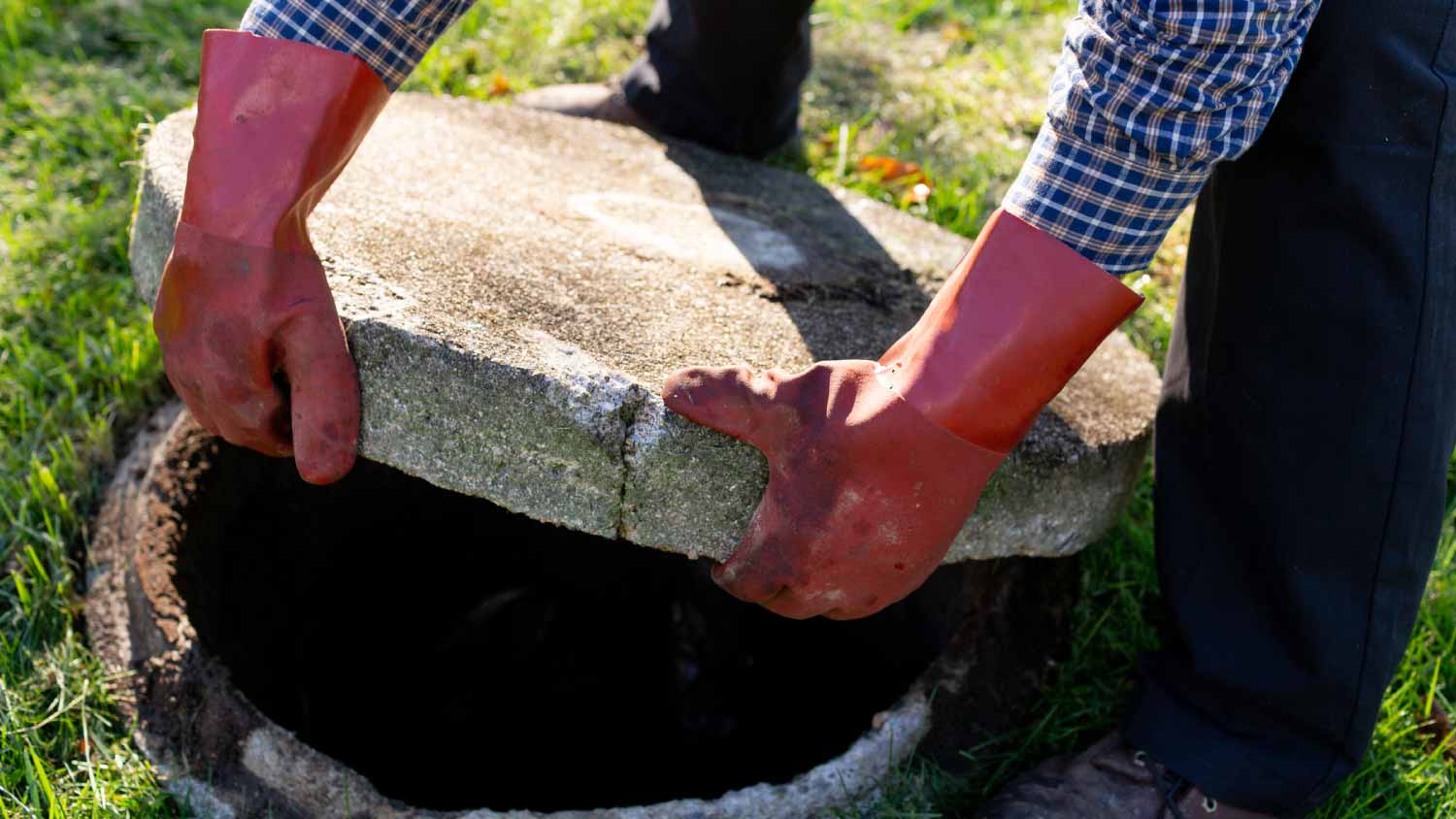
Problem:
Blockages in your sewer line could result in gross (and unhealthy) backups in your home. You may smell the problem before you see it, so it’s important to act fast.
Solution:
Any type of sewer line blockage or repair should be handled by a licensed sewer line repair company in your area. It’s difficult work, it’s crucial that it’s done right, and you’re exposed to hazardous waste materials when working on the repairs. In some instances, you may need to replace the entire sewer line. On average, sewer line replacement costs $3,080.
11. Sump Pump Problems
Problem:
A sump pump is crucial for preventing floods in your basement, but it could stop working for a number of reasons, including electrical power failure, incorrect installation, clogs, and too much water from heavy rain or snow. It’s important to keep up with sump pump maintenance to prevent yours from failing prematurely.
Solution:
You can try troubleshooting your sump pump on your own if you have moderate DIY skills, but if you aren’t sure of the source of the problem—or confident in how to fix it—it makes more sense to contact a sump pump repair company near you.
Sump pumps normally last about 10 years. If you’re seeing problems near the end of its life, it may make more sense to replace it. On average, sump pump replacement costs between $300 and $750.
12. Changing Water Color
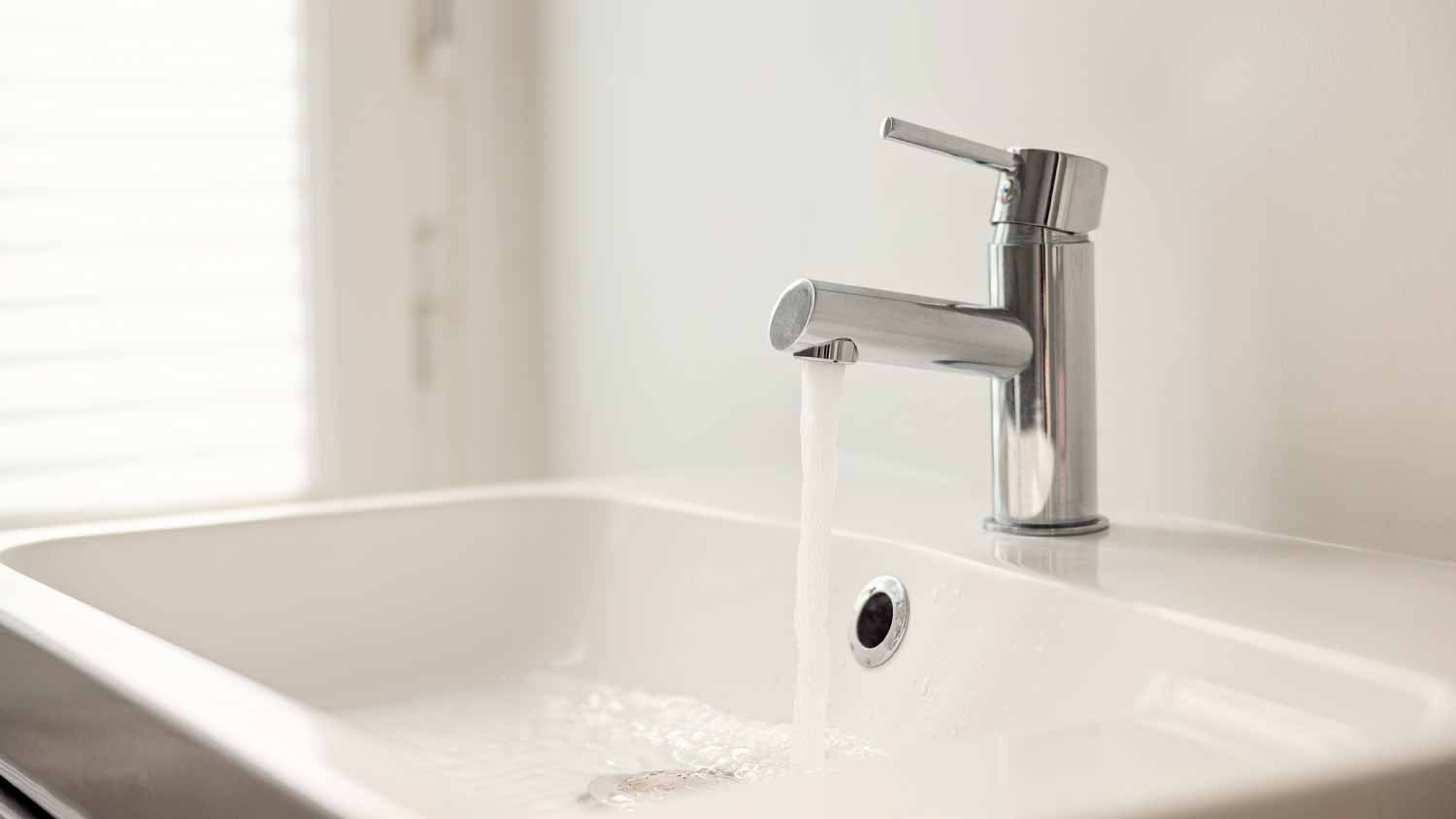
Problem:
Water should run clear, so what does it mean when yours starts to turn brown or reddish? There could be some kind of sediment in your water, or it could be an indicator of rust, either in the water heater, municipal water piping, or your own pipes.
Solution:
Ask your neighbors if their water has also changed color. If so, something is wrong with the city’s infrastructure that provides water. If it’s just you, however, you’ll need to hire a plumber to find and fix the source of the problem.
13. Standing Water on the Lawn
Problem:
Excessive puddling or wet spots on your lawn could simply be a sign that you need to have your yard regraded, but it could also indicate an issue with your downspouts, sewer main, water main, or septic system.
Solution:
If the issue is with your landscaping, hire a local landscaper to regrade your lawn so that water properly drains away from your home and doesn’t flood your home. Regrading a yard costs $2,125 on average.
If the problem isn’t with your landscaping, you’ll want to have a plumber investigate the source of the problem. Because there could be so many complex sources—and all of them difficult to fix—it’s best to leave this in the hands of a capable pro.
14. Frozen Pipes
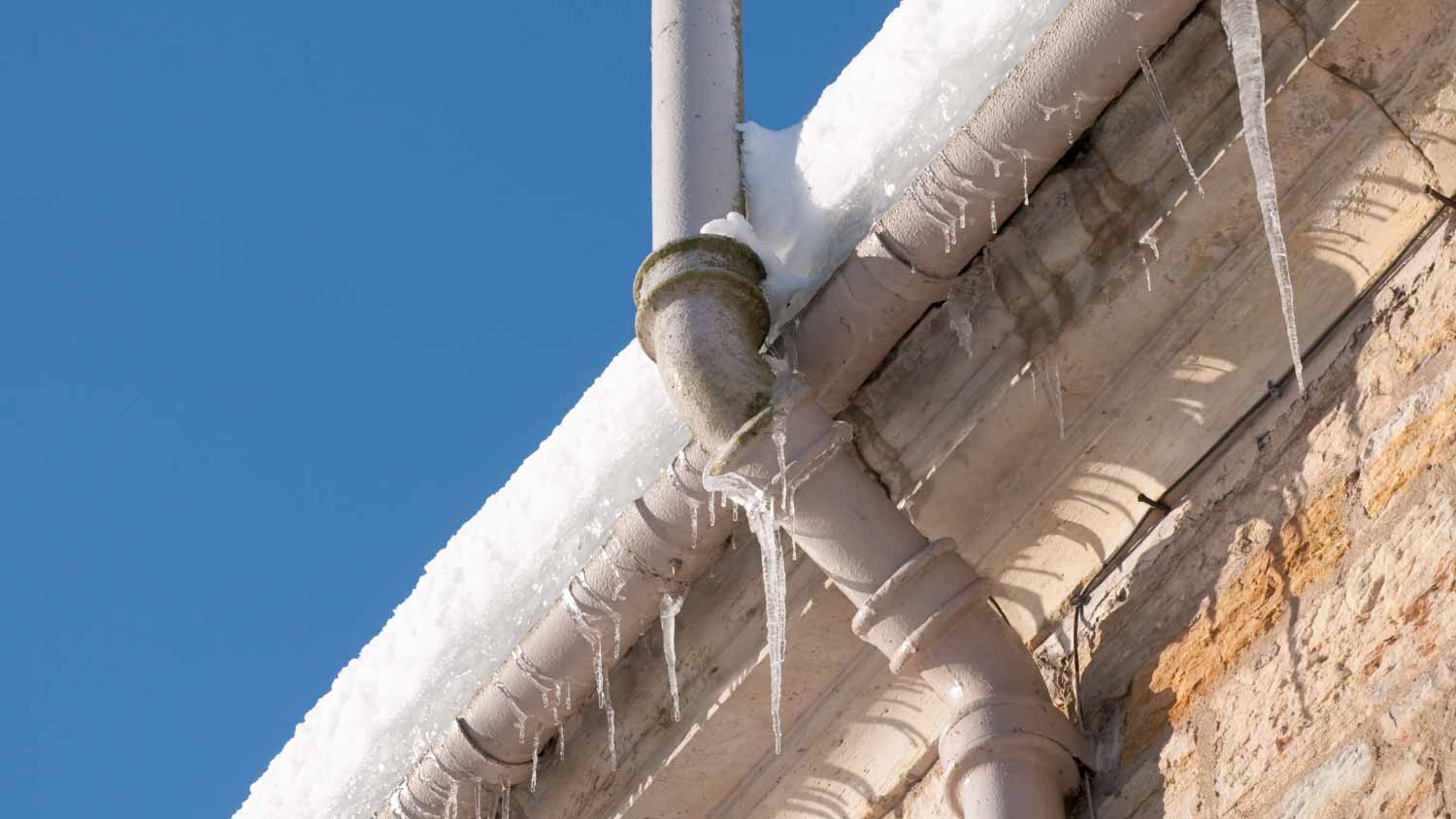
Problem:
Pipes can freeze at temperatures of 20 degrees Fahrenheit or below, but there are several ways to keep your pipes from freezing even at lower temps, like insulating your pipes, keeping the heat running even when you’re gone, and letting faucets slow-drip during winter storms.
Solution:
If your pipes do freeze, it’s important to thaw them before they burst. Here’s how to unfreeze your pipes on your own, but for more serious problems—and to prevent burst pipes in a winter emergency—you should probably call a local plumber, who can quickly thaw your pipes with a heat gun. It’s even more challenging to thaw frozen pipes underground, but it’s possible—and may be crucial during a winter storm.
15. Bubbling Paint or Ceiling
Problem:
Bubbling paint on your walls or on your ceiling could indicate some kind of water leak that you’re not able to see. It may not be plumbing related, however; it could also indicate a roof or gutter leak.
Solution:
Don’t mess around when you see bubbling paint. Investigate the source of the issue right away. If it’s a leaky pipe, call a plumber, but if your roof is leaking, you’ll need to find a local roofing company right away before the damage becomes more extensive.
16. Leaking Hose Bib
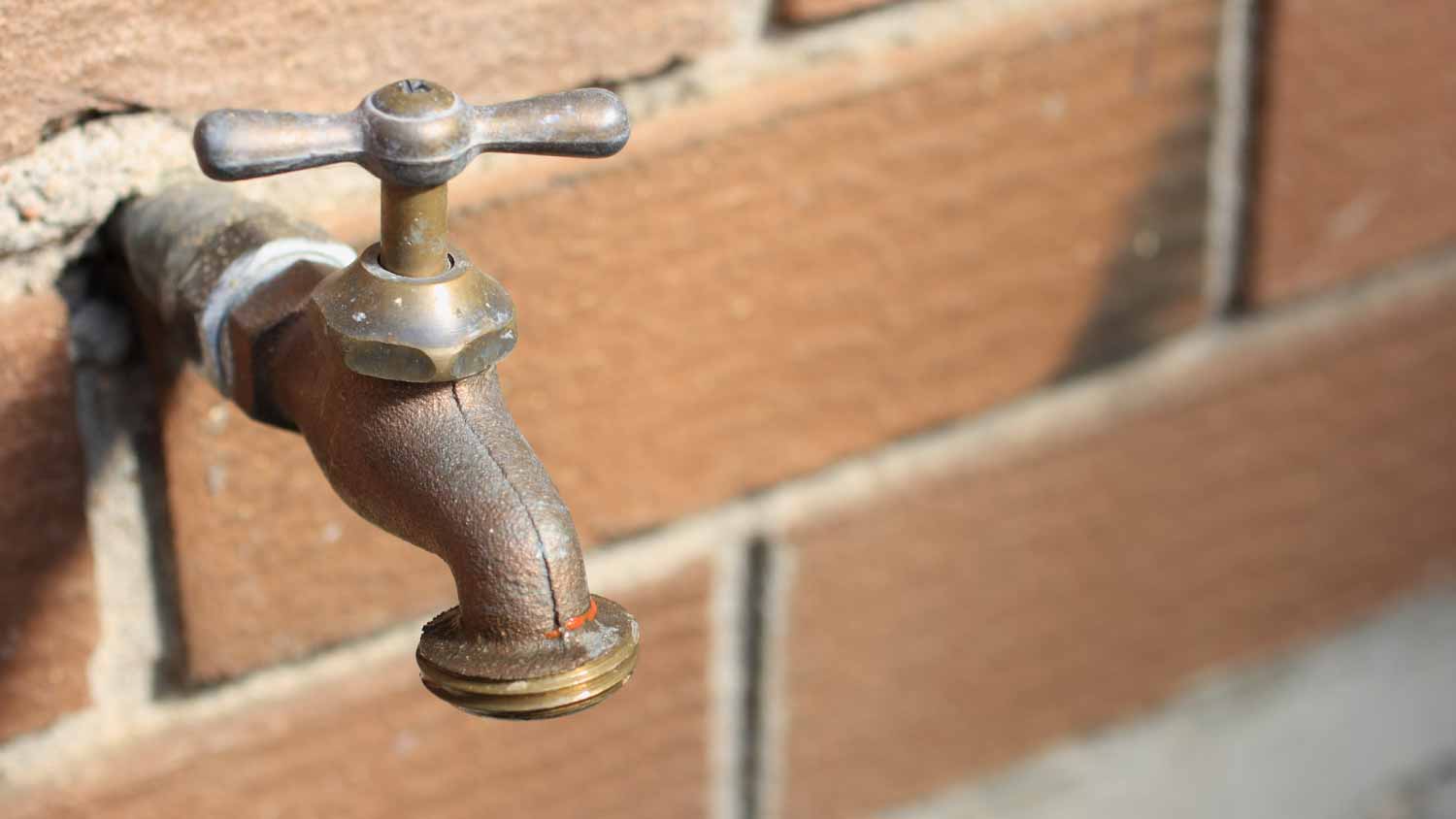
Problem:
Don’t forget to monitor your exterior faucets for leaks as well. A leaky hose bib could result in a slow drip when the spigot is off and a fast leak at the connection point when the hose is on. Hose bibs tend to deteriorate after several years of use, but they can also just crack because of extremely cold temperatures.
Solution:
You should replace a worn-out hose bib as soon as you notice the problem, or you risk paying an excessively high water bill. You can purchase frost-resistant hose bibs to prevent the problem going forward. Savvy DIYers may be able to fix a faulty hose bib on their own, but it’s also something a plumber can tackle in under an hour. For this kind of project, a plumber costs $100 to $200.
17. Water Hammer
Problem:
Water hammer refers to the loud and unexpected sound of water in your plumbing. It occurs when there’s a sudden pressure that stops the flow of water, like turning off the faucet of a sink or shutting off a water appliance (washing machine, dishwasher). The water, which was flowing rapidly, suddenly stops or even reverses direction, sending a shockwave through the plumbing.
This water pipe noise can be alarming (and unpleasant), but more importantly, this plumbing phenomenon is also bad for your pipes. Over time, the pipes can become damaged, leading to leaks, burst pipes, or issues with your appliances.
Solution:
Water hammer is an issue plumbers are used to dealing with, and they can likely quickly resolve this common plumbing problem and recommend some solutions to prevent it in the future. That said, you can try to DIY the solution before calling in the pros, if you’d prefer. Start by draining your pipes and then refilling them, which will create new air chambers. Try using your faucet or appliances to see if the sound is gone.
To prevent the water hammer effect in the future, you can install water hammer arrestors to key pipes in your plumbing.
18. Spiking Water Bill
Problem:
A sudden or even gradual increase in your water bill—without a rise in the price of water or a change in how much water you’re using—is potentially a sign of a leak you haven’t yet discovered.
Solution:
One high utility bill doesn’t mean you should sound the alarm, but spend some time investigating your faucets and pipes to check for drips and leaks. Listen to your toilet to determine if it’s running when not in use, make sure your appliances and water heater aren’t leaking, and don’t forget to check outdoor faucets.
If you can’t find any leaks, keep an eye on your utility bill. Continued increases in your bill could mean it’s time to call in a pro to investigate further.
Plumbing Maintenance Tips
The best way to avoid these common plumbing problems? Keep up with easy, routine maintenance. Here are some of our best plumbing maintenance tips to avoid emergency plumbing issues:
Only flush waste and toilet paper down the toilet.
Routinely check for leaky faucets and showerheads.
Inspect appliances regularly for leaks.
Don’t overuse your garbage disposal.
Clean your drains regularly.
Turn off outdoor fixtures in the winter.
Test your water pressure regularly.
When to Call a Plumber vs. DIY
Fixing simple plumbing problems may be within your wheelhouse, particularly if you have some basic tools at home and have prior experience working on plumbing. But if a problem feels particularly complicated, it’s usually safer to call in the professionals.
Don’t wait too long when it comes to your plumbing. Leaving plumbing problems unaddressed could cause the issue to grow and could also pose a health hazard to you and your family. When in doubt, find a trusted, affordable plumber near you who can fix the problem without breaking the budget.
What to Do in a Plumbing Emergency?
Every plumbing problem won’t require immediate assistance, but there are a few plumbing emergencies — ruptured pipes, water heater leaks, and overflowing toilets — that need quick attention.
In the event of a plumbing emergency, you should:
Turn off the water. Turn the water off for a specific fixture — a sink or toilet — if you can. If not, turn off the main water line.
Take pictures. Having pictures or videos of your problem can help a plumber offer a quicker and more accurate assessment.
Evacuate your home (if necessary). Depending on the scenario and the extent of the damages, you may need to evacuate your home while you arrange to have your home accessed and repaired.
Get the situation fixed ASAP. If left unfixed, plumbing issues can spiral and lead to larger, costlier damages that include fixing water damage and mold. On average, water damage restoration costs $3,773, while the average cost for getting rid of mold ranges between $1,125 and $3,345.
Call an emergency plumber. You should screen a couple of plumbers to see who provides a mix of affordable, experienced, and timely services. Because they may have to come out after hours, during weekends, or on holidays, the cost for emergency plumbing may be around $70 to $400 per hour.
Questions to Ask the Plumber Before Hiring
In the middle of a plumbing emergency, you won’t have much leisure to take your time contacting multiple professionals and weighing their pros and cons. Even so, you should still reach out to a few of them to make sure they’re the right plumber for the job. In addition to sending them any pictures of your plumbing problem — through text or email — you should have some questions ready that can help you quickly narrow down your choices and find a plumber who’s affordable, knowledgeable, and experienced.
Whether you’re having a conversation over the phone or an in-person meeting at your home, consider asking:
Are you licensed and insured?
How many years of experience do you have, and do you have experience with this specific type of job?
What’s your soonest availability, and how long will it take to fix?
Can my emergency repair wait until you’re available? If not, can you suggest a temporary fix?
Is a permit required, and if so, will you apply for it?
What is the cost of this job, and do you offer any warranties or guarantees?





- Gas Plumbers
- Plumbing Repairs
- Sump Pump Installation
- Wood & Pellet Stove Repair
- Shower Repair
- Wood Stove Services
- Emergency Plumbers
- Fire Sprinkler Contractors
- Perc Test Companies
- Toilet Repair & Installation
- Boiler Repair
- Sewer Line Repair
- Faucet Repair
- Main Drain Camera Companies
- Foundation Drain Installation
- French Drains
- Bathtub Replacement
- Subcontractors
- Storm Drain Contractors
- Affordable Plumbing
- Plumbing & Heating Companies
- Bathroom Repair Services
- Sink Installation
- Commercial Plumber
- Barndominium Builders
- Water Line Repair
- Faucet Installation
- Water Line Installation
- Leak Detection
- 14 Preventive Plumbing Maintenance Tips You Should Know
- 10 Most Common Plumbing Problems Every Homeowner Should Know
- 7 Plumbing Features to Check Before Buying a New Home
- What Counts as a Plumbing Emergency?
- 6 Essential Plumbing Emergency Tips
- Can Cold Weather Cause Pipes to Leak? How to Fix and Prevent
- No Water Coming Out of Your Faucets? Here’s Why and What to Do About It
- 14 Reasons Your Water Is Only Lukewarm
- 14 Must-Know Winter Plumbing Tips
- How to Tell If Your Bathroom Plumbing Needs Repair










